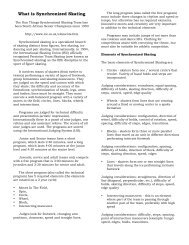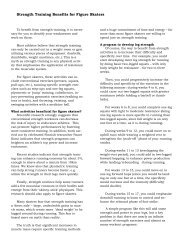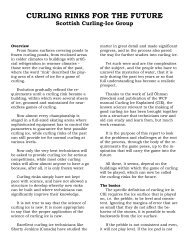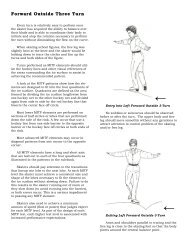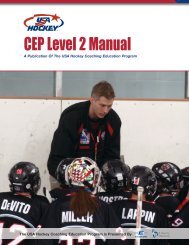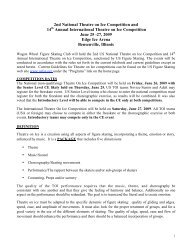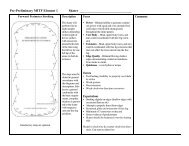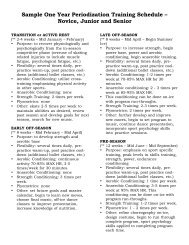CEP Level 3 Manual - Rushmore Hockey Association
CEP Level 3 Manual - Rushmore Hockey Association
CEP Level 3 Manual - Rushmore Hockey Association
Create successful ePaper yourself
Turn your PDF publications into a flip-book with our unique Google optimized e-Paper software.
T A B L E O F C O N T E N T SHighHighAverageAverageLowLowPhysicalMentalSocialEmotionalPhysicalMentalSocialEmotionalExample 1: Player A (Male)Example 2: Player B (Female)Figure 1: Schematic illustration of the interaction between the four main areas of Development.motor skill coordination (eye-hand, eye-foot),physical health, and body composition.What is mental development?Mental development consists of memory,perception, language, information processing, andthought processing which influence decisionmakingand the understanding of the rules of playand team concepts.What is social development?Social development refers to the ability tointeract effectively and get along with others.Appropriate social behavior consists of being able toget along withteammates, coaches, parents, as wellas showing respect for team and league rules. In ateam sport such as hockey, athletes mustunderstand their roles on the team.What is emotional development?Emotional development is part of a person’spersonality development. It refers to the ability toexpress and control one’s emotions. For example,before a big game it is important for players tocontrol their level of anxiety or nervousness. Also, infrustrating situations, such as after an unintentionalpenalty or rough play by the opposition, it is84 | USA <strong>Hockey</strong> Coaching Education Program <strong>Level</strong> 3 <strong>Manual</strong>important for players to keep their cool and displaydisciplined behavior.DIFFERENCES IN DEVELOPMENTIt is important to remember that even thoughthe four main areas of development are highlyinterrelated, there may be different rates ofdevelopment in each of these areas for each player.As a result:• There may be substantial differencebetween athletes in terms of the levels oftheir physical, mental, social, and emotionaldevelopment.• There may be differences within athletes interms of the levels of their physical, mental,social, and emotional development.• It may be useful for coaches to createdevelopmental profiles for each player.Each athlete is unique, therefore, each growsand matures at a different rate. The following twoexamples will highlight differences between andwithin players in terms of their stages ofdevelopment in each area.For this player, we can see that his level ofphysical development is more advanced than hislevels of mental, social, and emotionaldevelopment. The behavioral implications of thisdevelopmental profile may be the following:• This athlete will be bigger and stronger thanmost of his teammates and he may possessexcellent hockey skills.• Due to the lag in the level of mentaldevelopment, this athlete may tend to playas an individual without regard for the teamstrategy which the coach is trying toimplement.• Teammates may begin to reject this playerbecause he is a “puck hog.” He maybecome a “loner” and his socialdevelopment may suffer as a result.• The lack of emotional maturity may causethis player to become easily frustrated whenthings do not go well. He may exhibitemotional outbursts, such as tempertantrums or arguments with teammates orcoaches. During early adolescence, thesetantrums may result from frustration and aretypical of low emotional maturity.For this player, we can see that her level ofphysical development is not as far advanced as herlevels of mental, social, and emotionaldevelopment. The behavioral implications of such adevelopmental profile may be the following:• This player will be smaller and physicallyweaker than many of her teammates.However, she may possess excellent timingand coordination.• This athlete’s level of mental or intellectualdevelopment will enable her to graspquickly the concepts of her team’s offensiveand defensive strategies.• The level of social development may lead tothis player being very popular with herteammates.• This athlete’s advanced level of emotionalmaturity will help her to control heremotions and thereby allow her to refrainfrom undesirable actions such as takingunnecessary retaliation penalties.Sport Psychology | 85



